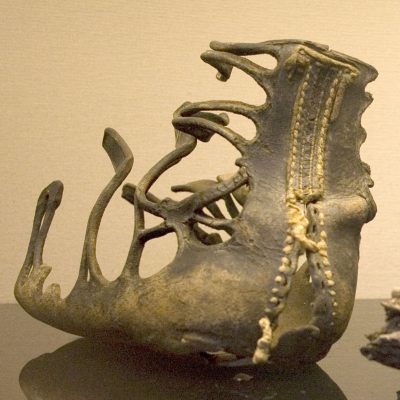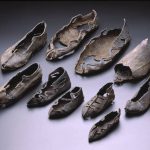Caligae (singular caliga) were footwear worn by Roman legionaries or centurions. They were a form of shod sandals with exposed toes. The sandals were made of a thick, nailed sole consisting of several layers of leather. Goat, sheep, cow or ox skin was used to make the sandals. The sandals were attached to the feet with straps covering the instep and the lower leg. Additionally, leather or metal uppers covering the entire shin were worn.
The Caligae were perfect for summer combat and high temperatures when the foot skin was not fully covered and could breathe. The solid sole guaranteed the stability and durability of the footwear, and the lightness of the workmanship did not burden the legs. This type of footwear was also usually used by citizens, especially those doing manual work (farmers, miners), but probably without studs.
During expeditions into the rocky mountains, legionaries threaded cloths and cloth on their feet so as not to injure their feet. In colder climates (e.g. Britain), the socks were also worn (woollen or linen fabrics) to protect it from the cold. This is confirmed by a 2010 discovery in North Yorkshire (UK). There were found 14 military graves in which, next to the bodies of the buried Romans, there were the remains of sandals, including preserved fibres among the rust from sandal nails. This proves that ancient Romans could wear socks along with sandals, and thus extravagant fashion appeared much earlier than we think.
Interestingly, Roman sandals were cut to take into account the differences between the right and left feet, which was unusual at that time.
The Caligae were less useful on hard surfaces though. Josephus tells the story of how one of the centurions – a certain Julianus – slipped on the marble floor of the Temple in Jerusalem. This is how Josephus Flavius describes it:
For as he had shoes all full of thick and sharp nails; as had every one of the other soldiers; so when he ran on the pavement of the temple, he slipped, and fell down upon his back with a very great noise which was made by his armour. This made those that were running away to turn back. Whereupon those Romans that were in the tower of Antonia set up a great shout, as they were in fear for the man. But the Jews got about him in crouds, and struck at him with their spears, and with their swords, on all sides.
– Josephus Flavius, Jewish War, VI.8
Regardless, today it is believed that shoes were ideal for long marches, and the rhythmic march of legionaries in upholstered shoes must have made a terrifying sound on the opponent.
The nickname of the emperor Caligula (Caligula, meaning “little caliga”) came from the name of sandals. Caligula was in a camp on the Rhine as a little boy; there his father, a Roman general Germanicus, showed his soldiers Caligula, dressed in a child’s legionary outfit. This is how Suetonius tells us this story:
His surname Caligula he derived from a joke of the troops, because he was brought up in their midst in the dress of a common soldier.
– Suetonius, Caligula, 9
Finally, it is worth noting that all shoes and sandals were made by a shoemaker (sutor), who was a valuable craftsman and whose services were especially appreciated in the army.








